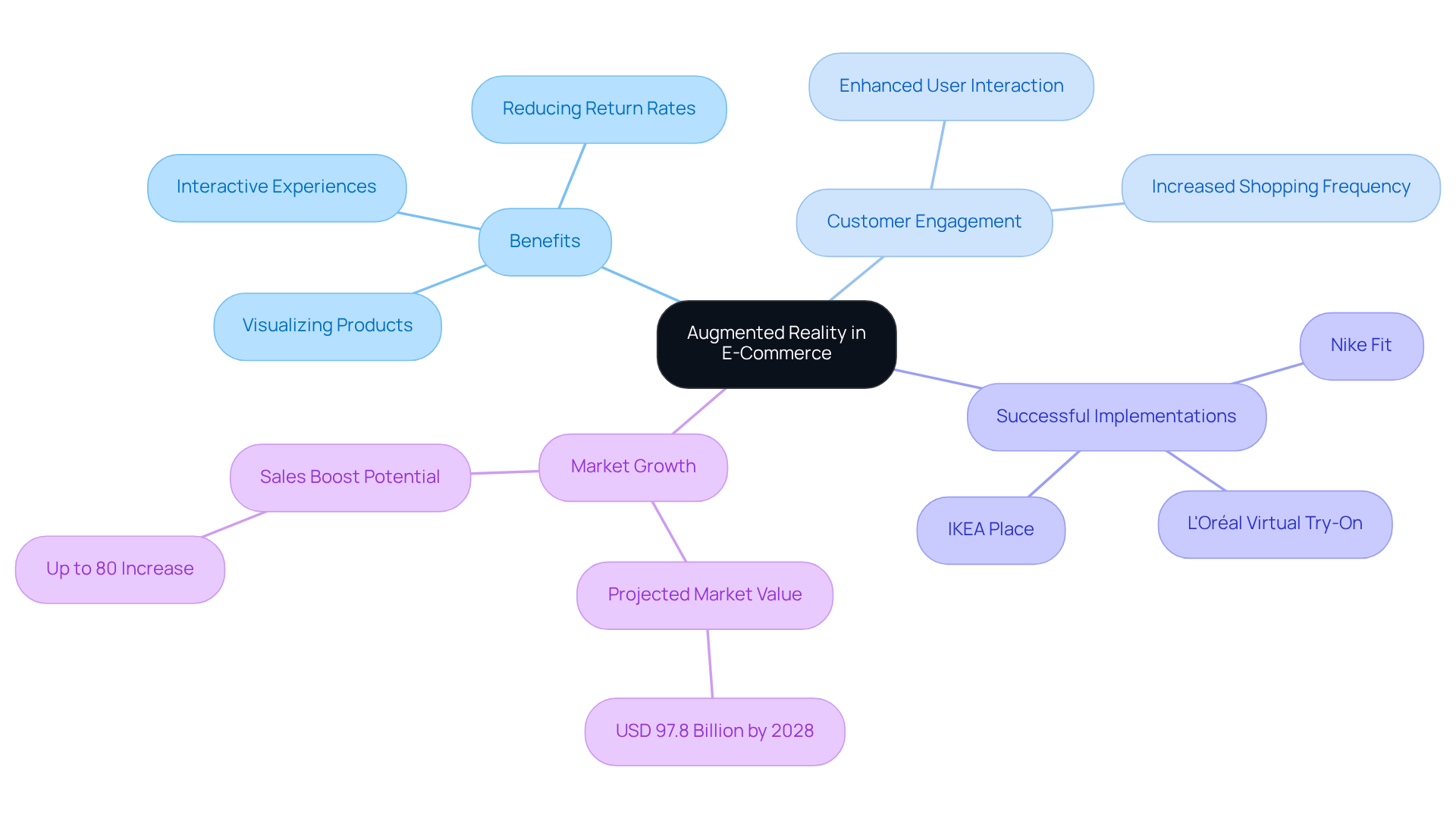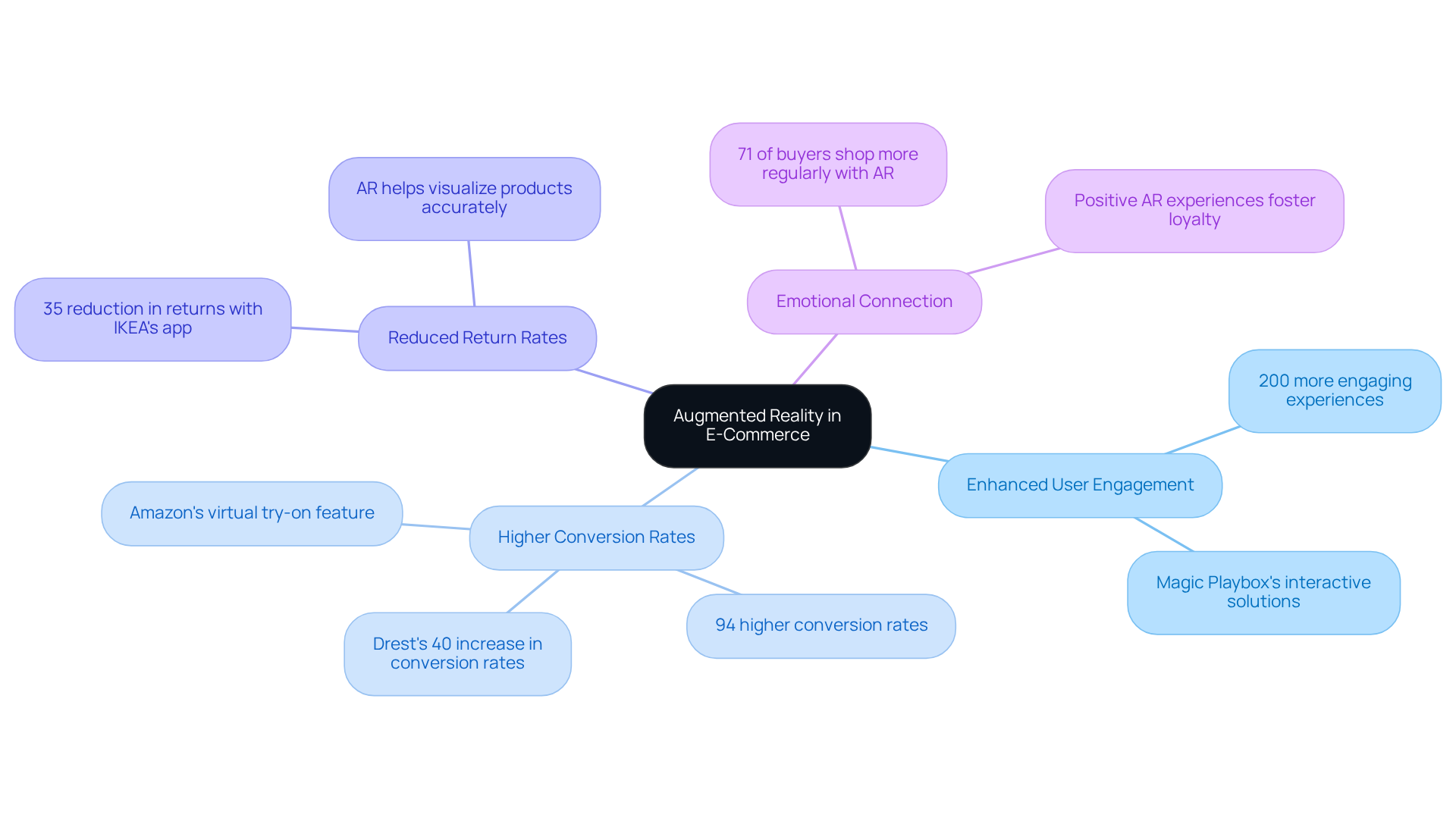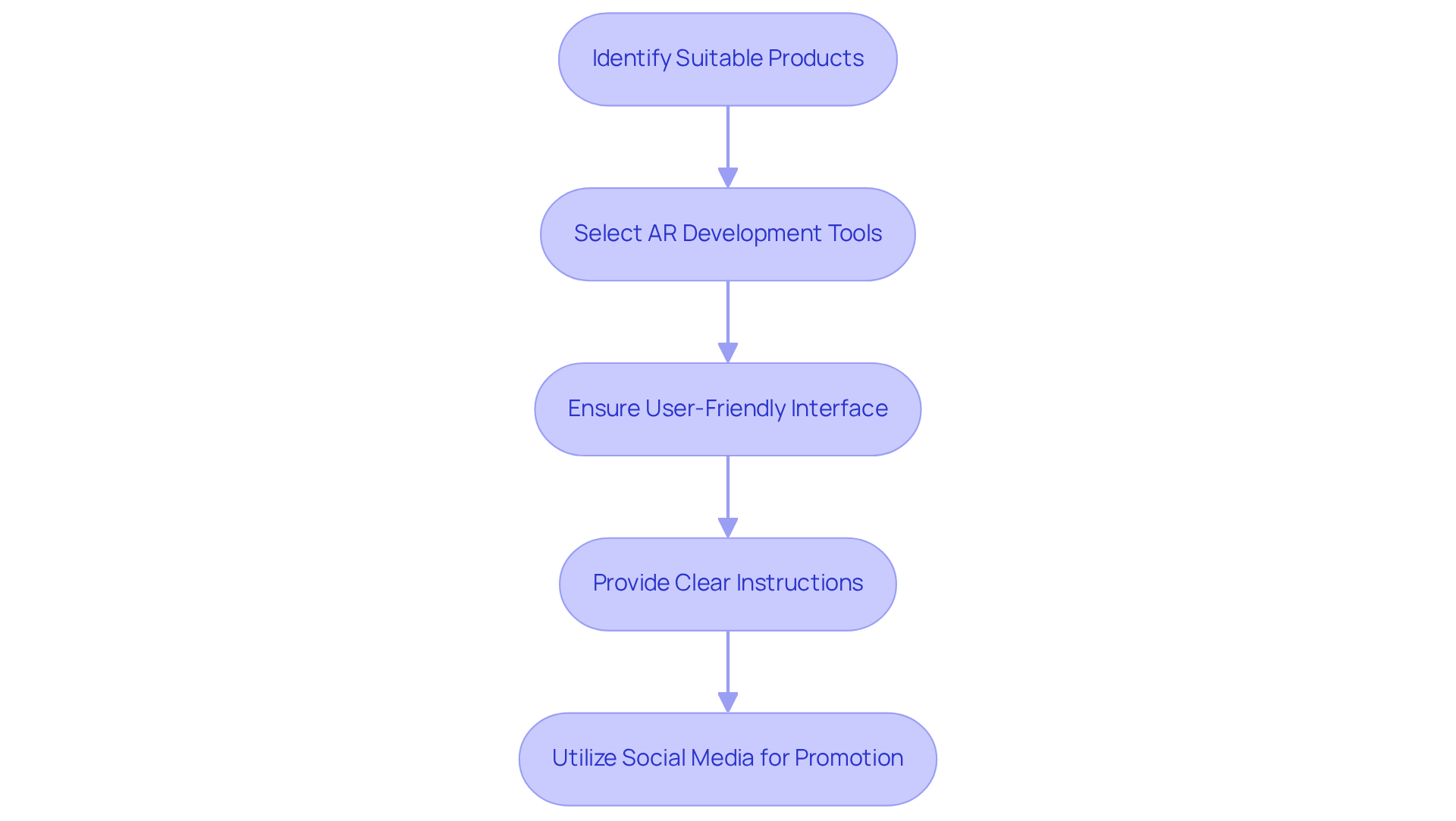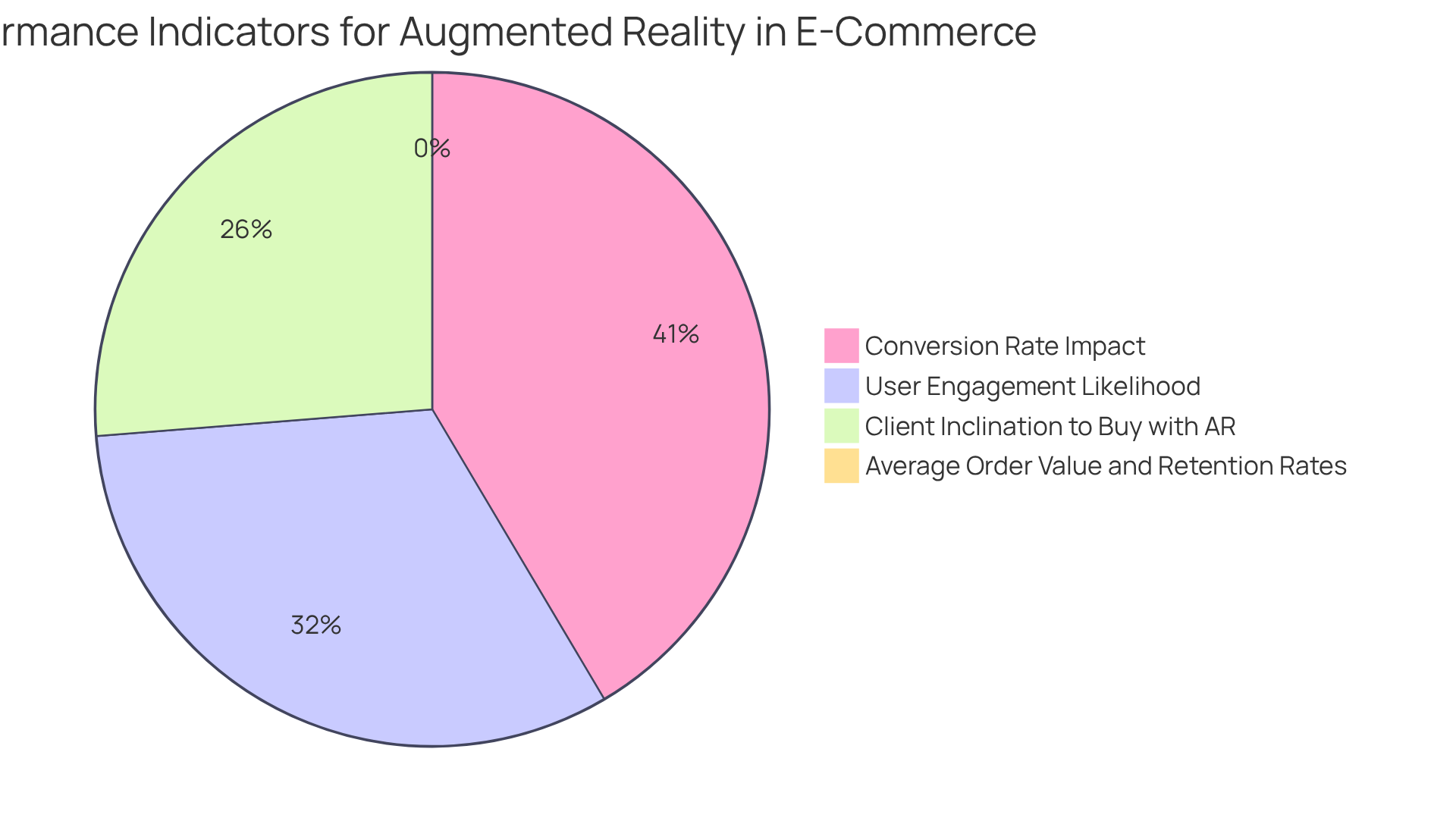Overview
The article presents four pivotal augmented reality (AR) solutions poised to significantly enhance e-commerce engagement. By improving user interaction and minimizing return rates, these solutions are transforming the online shopping landscape. Notably, applications such as IKEA's AR app serve as exemplary models, illustrating the strategic integration of AR technology. Furthermore, measuring AR's impact on conversion rates and customer satisfaction is crucial, as research indicates that these factors directly correlate with a more immersive shopping experience and increased sales. Brand managers must recognize the benefits of adopting these proven strategies to stay competitive in the evolving market.
Introduction
Augmented reality (AR) is revolutionizing the e-commerce landscape, seamlessly merging the digital and physical realms to craft an unparalleled shopping experience that captivates and engages consumers. As this groundbreaking technology gains momentum, businesses are uncovering its vast potential to elevate customer interactions, increase conversion rates, and minimize return rates.
Yet, a pivotal question persists: how can brands effectively implement AR solutions to not only meet but surpass the evolving expectations of today’s discerning shoppers? By delving into the key strategies and benefits of AR in e-commerce, we unveil a pathway for brands to not merely survive but thrive in an increasingly competitive market.
Understand Augmented Reality in E-Commerce
Augmented reality (AR) in e-commerce seamlessly integrates digital information with users' surroundings in real-time, revolutionizing the shopping experience. This technology empowers users to visualize products within their own environments—whether it’s assessing how a piece of furniture complements their living room or determining how a pair of shoes looks on their feet. By superimposing digital images onto the physical world, AR effectively bridges the divide between online and in-store shopping, fostering a more interactive and engaging experience.
Notably, research indicates that 71% of purchasers are inclined to shop more frequently if AR is available, underscoring its potential to enhance customer engagement and satisfaction. Successful implementations, such as IKEA's 'IKEA Place' app, illustrate how users can visualize furniture placement in their homes, while brands like L'Oréal and Nike leverage AR for virtual try-ons, significantly increasing conversion rates.
Magic Playbox stands at the forefront of this innovation, offering tailored AR solutions that enhance interactions and involvement in online shopping. By harnessing Magic Playbox's technology, companies can craft immersive AR experiences that not only captivate clients but also reduce return rates by facilitating virtual try-ons prior to purchase.
As online retail evolves, recognizing AR's pivotal role—particularly through the lens of Magic Playbox's offerings—is crucial for brands striving to remain competitive and meet the ever-changing expectations of consumers. The AR market is projected to soar to USD 97.8 billion by 2028, highlighting the imperative of embracing AR technology for future growth.

Leverage Benefits of Augmented Reality for Enhanced Customer Engagement
Incorporating augmented reality solutions into e-commerce presents a compelling opportunity to significantly enhance user engagement. AR delivers an immersive shopping experience, allowing consumers to interact with products in ways that traditional online shopping simply cannot replicate. Research indicates that products featuring AR content achieve conversion rates up to 94% higher than those without. Furthermore, AR effectively reduces return rates by enabling shoppers to visualize products accurately before making a purchase, thereby boosting consumer confidence and fostering a deeper emotional connection with the brand.
For instance, Magic Playbox has developed augmented reality solutions that have empowered companies to enhance customer engagement and decrease return rates. By harnessing the potential of AR, online retail companies can cultivate unforgettable interactions that not only encourage repeat purchases but also nurture customer loyalty.

Implement Effective Strategies for Integrating AR into E-Commerce Platforms
To effectively integrate augmented reality solutions into e-commerce platforms, companies must adopt several strategic approaches.
- It is essential to identify products that would benefit from AR visualization, particularly those requiring fitting or spatial context, such as clothing, furniture, or accessories.
- Next, selecting appropriate AR development tools that align with your business objectives is crucial; for instance, ARKit is ideal for iOS applications, while ARCore is suited for Android.
- Ensuring that the AR interface is user-friendly and accessible across various devices is vital, as research indicates that AR can enhance user engagement by up to 200% compared to non-AR options.
- Providing clear instructions and robust support can further elevate user interaction and satisfaction.
- Furthermore, utilizing social media platforms to showcase AR features can greatly enhance visibility and user involvement, as companies like IKEA have demonstrated with their effective AR applications.
By applying these proven strategies, online retailers can develop a seamless and engaging augmented reality environment that not only improves consumer interaction but also boosts sales and loyalty.

Measure and Optimize the Impact of Augmented Reality Solutions
To effectively measure the impact of augmented reality solutions, e-commerce companies need to establish key performance indicators (KPIs) that align with their specific business objectives. Key metrics encompass:
- Conversion rates, which can rise by as much as 90% for users interacting with AR.
- Average order value.
- Retention rates.
Research indicates that 57% of clients are more inclined to buy from brands that offer augmented reality solutions. Collecting client feedback through surveys and user testing is essential for pinpointing areas requiring enhancement. Furthermore, examining user engagement data offers insights into how individuals interact with AR content. Notably, over 70% of shoppers are more likely to purchase when they can engage with products through augmented reality solutions.
By continuously optimizing augmented reality solutions based on these insights, e-commerce businesses can significantly enhance customer satisfaction and drive sales growth. For instance, Zoff reported a fourfold increase in conversions after implementing augmented reality solutions such as a virtual try-on tool, showcasing the tangible benefits of AR in retail. As the AR market is projected to reach $80 billion by 2025, brands that prioritize these metrics will be well-positioned to lead in the evolving digital landscape.

Conclusion
Augmented reality (AR) is revolutionizing the e-commerce landscape, creating immersive shopping experiences that seamlessly integrate the physical and digital realms. This technology not only enhances user engagement but also significantly boosts conversion rates and customer satisfaction. By allowing consumers to visualize products in their own environments, AR effectively addresses the limitations of traditional online shopping, positioning itself as an essential tool for brands seeking to excel in a competitive market.
The integration of AR into e-commerce offers several key benefits, including:
- Increased conversion rates
- Reduced return rates
- Enhanced customer loyalty
Successful implementations by companies such as IKEA and L'Oréal illustrate the tangible advantages of AR solutions, while tailored technologies from firms like Magic Playbox facilitate these transformative experiences. Moreover, strategic approaches to AR implementation—such as selecting suitable products and development tools—are crucial for maximizing its effectiveness.
As the AR market is projected to reach USD 97.8 billion by 2028, e-commerce brands must prioritize the adoption of augmented reality technologies. This commitment not only aligns with the evolving expectations of consumers but also positions brands for sustained future growth. Embracing AR is not merely a trend; it represents a strategic initiative that can redefine the online shopping experience and cultivate lasting connections with customers.
Frequently Asked Questions
What is augmented reality (AR) in e-commerce?
Augmented reality in e-commerce integrates digital information with users' surroundings in real-time, allowing them to visualize products within their own environments, enhancing the shopping experience.
How does AR improve the shopping experience?
AR allows users to see how products, like furniture or clothing, would look in their own space or on themselves, bridging the gap between online and in-store shopping and creating a more interactive experience.
What percentage of purchasers are likely to shop more frequently with AR?
Research indicates that 71% of purchasers are inclined to shop more frequently if AR is available.
Can you provide examples of successful AR implementations in e-commerce?
Successful implementations include IKEA's 'IKEA Place' app, which helps users visualize furniture in their homes, and brands like L'Oréal and Nike, which use AR for virtual try-ons, improving conversion rates.
What role does Magic Playbox play in AR for e-commerce?
Magic Playbox offers tailored AR solutions that enhance user interactions in online shopping, providing immersive experiences that can captivate clients and reduce return rates through virtual try-ons.
Why is it important for brands to adopt AR technology?
As online retail evolves, adopting AR technology is crucial for brands to remain competitive and meet changing consumer expectations, with the AR market projected to reach USD 97.8 billion by 2028.




